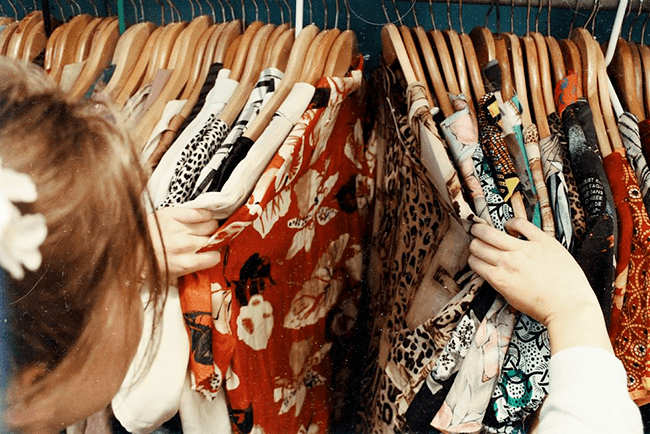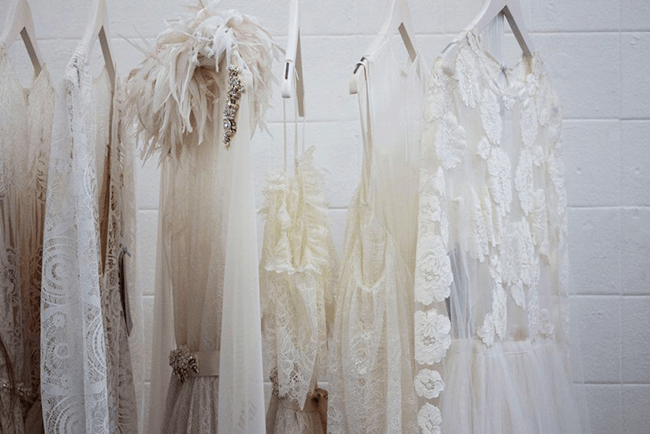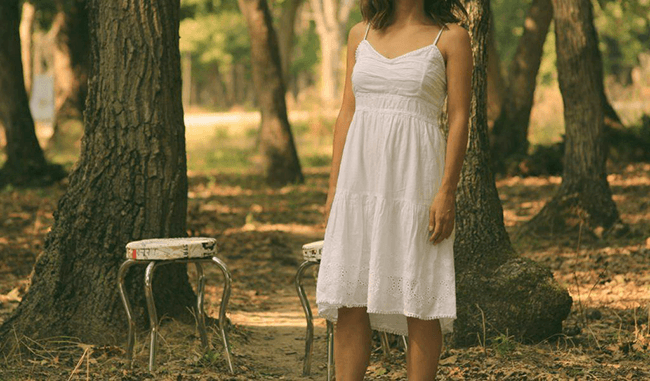Dresses are the go-to outfits for special occasions, the perfect way to slip on a sheath of confidence for a job interview or date, and a great way to flatter figures of all kinds.
No human body is the same. We come in all shapes and sizes, from shapely hourglasses to powerful triangles to plump apples. They are all beautiful!
Being able to make dresses of every cut and style means being able to create unique outfits for each unique individual.
Here we look at 20 different types of dresses – from wardrobe staples, to stunning themed outfits for special occasions.
Looking for dress-themed inspiration? Let’s get started!
20 Different Types of Dresses

Take your business to the next level by mastering the roster of different dress styles below!
These are the most popular types of dress cuts, and will really buff out your sewing portfolio.
It is important to know that while many dress types suit certain figures, with a little bit of creativity on your part, just about any style of dress can be tailored to fit.
See more: How to sew a dress.
Babydoll
The Babydoll is a cute, thigh-length dress that cinches under the bust and flares out over the waist and hips.
Typically strapless, these dresses are mostly for casual wear and special occasions; although, when paired with a jacket and leggings, Babydoll dresses are perfect for casual office wear.
Of all the cuts, babydolls are among the simplest and easiest to make.
Bubble
Bubble dresses can have multiple sleeve and collar designs. What makes their design unique is the hem, which is folded back in on itself to create the bubble effect – after which the style is named.
Perfect for parties and hitting the town, the Bubble dress is a sweet addition to any wardrobe. This dress offers a cute, stylish look and provides quite the creative challenge for designers.
Corset
Corset dresses are heavily inspired by the classic Victorian corset. Modern corset dresses have structured tops, though not often with the same rigidity or boning as their ancestors, and loose, free-flowing skirts that can be any length.
Depending on the material and skirt style you use, Corset dresses can have a number of aesthetics, from gothic to sleek chic.
Designers that enjoy creating structured garments will love creating a Corset dress.
See more: How to sew a corset.
Maxi
The Maxi dress surged back into popularity in recent years, offering the perfect solution to temperamental weather.
Pairing Maxi dresses with bomber, leather, or denim jackets and boots offers an edgy look perfect for cooler months, while the Maxi and gladiator sandals look is number one in summer!
The Maxi is not tailored and drapes over the form, giving you lots of room to play with all sorts of fun materials and necklines.
Shirtwaist
The Shirtwaist is a vintage style dress that has a top-style fitted closely like a vest, shirt, or blouse, and has a skirt that flares out from the waist.
Skirt lengths vary from just above the knee to ankle length, and sometimes pleating is included for extra volume.
The Shirtwaist is a good dress for designers to play around with material, style, and structure. Vintage dresses are never out of style!
Halter
Halter dresses are for parties and, with the right styling, for fancy events. The Halter dress is defined by the straps on the front that meet behind the neck.
Sometimes, they will have an open back, with skirts and tops that can have many stylings – although a gently flared skirt is popular!
As Halter dresses can have any styling outside of the straps, these are a great option for designers that want to test their creativity.

Fitted
The Fitted dress is the classic ‘it can do everything’ dress. Form-fitting and hugging your figure, this a dress for all occasions – from parties to office wear.
A range of collars and sleeves can be paired with this style, and the hem typically falls from mid-thigh to the knee.
Given the form-fitting nature of this dress, careful measurements and craftsmanship are needed.
Off-The-Shoulder
Suitable as event dresses and office wear in really, really upscale places, Off-The-Shoulder dresses have necklines instead of collars that cut straight across the collarbone.
The sleeves start in line with the neckline, exposing the tops of your shoulders. Sleeve and skirt length vary, but the dress itself is usually form fitting to cut a sleek figure below the neckline.
Neat stitchwork and careful measurements are needed to make a quality version of an Off-The-Shoulder dress. See some inspirational designs here.
One Shoulder
One Shoulder dresses are regal gowns and preppy party dresses, depending on the cut of the sleeve and the skirt length. Playing around with both can leave designers with a rack of One Shoulder dresses for all occasions!
The defining trait of the One Shoulder dress lies in its name, leaving the other arm and shoulder fully exposed. One Shoulder dresses are great for creating the illusion of height, as well as slimming the neck.
Drape
Drape dresses are cut in such a way that the fabric hangs loosely over the chest and back creating ripples of fabric that produce a unique aesthetic.
The collar and back of the dress often dip quite low, but the drapes of fabric prevent this dress from becoming too racy. This dress is perfect for any formal or casual occasion.
Working with the fabric to create a signature drape can be tricky, but so very worth it.
Mermaid
The Mermaid dress is an icon of glitz and glamor, favored by starlets of the Silver Screen. It hugged their figures and flared out at the knees for the divine mermaid look.
Although having faded in popularity today, with the right adjustments, any designer worth their salt will take on the challenge to modernize this look.
Requiring careful structuring, Mermaid dresses can be a real test of skill for designers.
Flapper
Hugely inspired by the Flapper style of the Roaring 1920s, Flapper dresses of today have waistbands that fall low on the hips with tops and skirts that remain loose on your figure.

Usually sleeveless and with high necklines, these dresses are cute and stylish, perfect for weekend brunches with friends – yet also great when it is time to hit the dance floor.
Flapper dresses can have all sorts of embellishments sewn into them for extra glamorous or vintage looks!
Gown
Gowns are the mark of a fancy event or an awards show with high-profile celebrities. Gowns can be tailored to be form fitting or free-flowing or a delicate wrap.
What marks a dress as a Gown is that it is full-length, and carefully styled for high-class occasions. Talk about fancy!
Gowns need to be crafted for each individual’s figure so that they are comfortable for the wearer and accentuate all the right parts.
Princess
Most often found in wedding dresses for its flattering cut, Princess dresses have fitted bodices, tapered waists, and free-flowing skirts. They are a beautiful number, and have a slimming effect on all body types.
Mastering this cut of dress will impress your clientele!
Strapless
Strapless dresses are any type of dress length, cut, or style that has a fitted bodice and no straps.
These dresses need to be carefully tailored, and sometimes require corsets or constructed tops, so that the wearer will not have a mishap (the dreaded nip-slip).
Providing a challenge, Strapless dresses are desirable for a number of occasions, and require a careful hand to create.
Empire
Empire dresses are flattering for all shapes and sizes, with a fitted top and a skirt cinched just under the bust.
They are popular as an all-around dress, great for casual get-togethers and office wear. Pairing well with leather jackets or soft cardigans, Empire dresses are hugely popular for their chic looks and versatility!
Pretty easy to make, and super fun to play around with styling and color blocking, Empire dresses are a great style to add to your kit.
Asymmetric
Asymmetric dresses are a designer’s dream! Great for slimming down figures and creating a wonderfully unique look, this style of dress almost has an ‘anything goes’ vibe – though nowhere near Avant Garde territory!
Typically, Asymmetric dresses will be a modified One Shoulder dress with a slanted hemline on the skirt as well. Depending on the affair for which the dress is needed, the slants can be gentle or severe.
Asymmetric dresses are fun to make and are open to each designer’s own creative whims!
Tunic
Tunic dresses are great for cooler months because of their long sleeves and high collars. Too short to be worn without leggings or jeans, Tunic dresses are great for casual office attire and make for excellent winter outfits!
Popular for their simplicity and cute look, Tunic dresses are simple to make and don’t have to be figure hugging to be flattering.
Lace
A plain dress can become special with a cut-out of lace over-layer! Lace dresses are popular for their delicate looks, and for the way they cheekily show a bit of skin without truly revealing any at all.
A lace dress can be either a dress with sections replaced by lace, such as a triangle of material under the collar and a large patch over the back, or a dress of plain material with an outer layer of lace.
Lace dresses are simple to make and offer a fresh twist on any wardrobe.

Flared
Flared dresses slim the figure with their fitted tops and skirts that flair gently at the hips. These dresses pair with all sorts of looks and, with the right accessories, can be turned from office attire into a party dress in minutes.
Unlike other dresses with cinched waists, Flared dresses have a more relaxed taper, offering a little more leeway for sizing.
Dresses For All Figures
Some designers will tell you that different types of dresses will only suit certain figures. This is absolutely not true!
All types of dresses can be adjusted and tailored to fit all of the beautiful bodies out there.
We have gone over the most popular dress styles today, covering their key characteristics and what occasions they are suitable for.
Now, what are you waiting for?
Break out your sketchbook and start designing!
What’s your favorite dress type?
